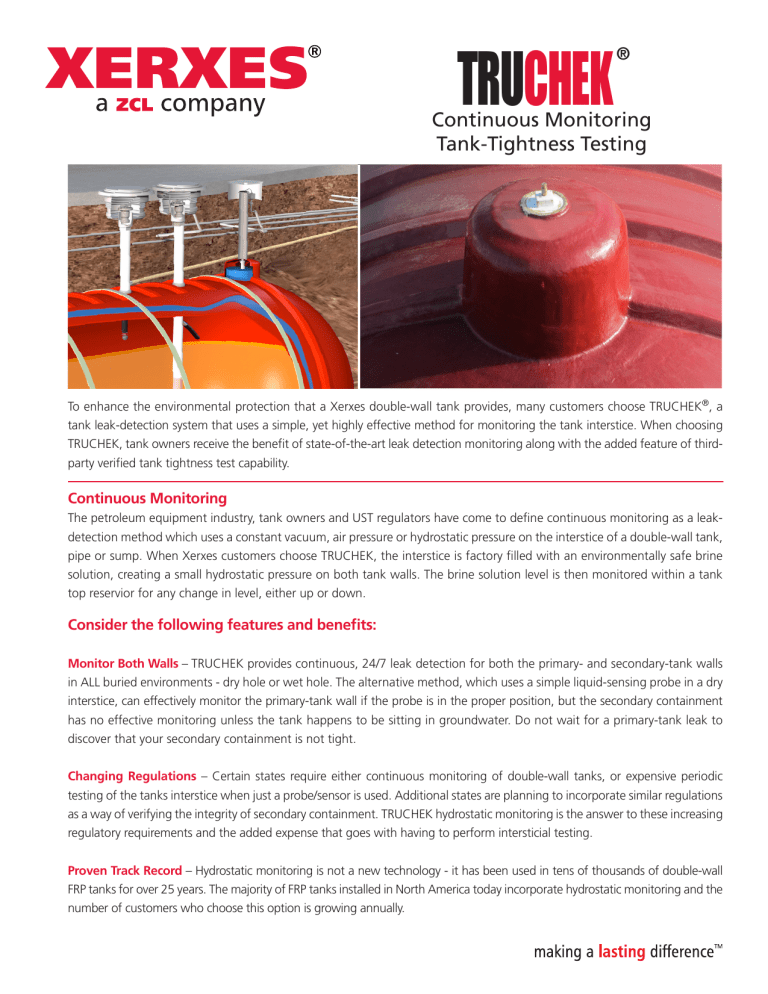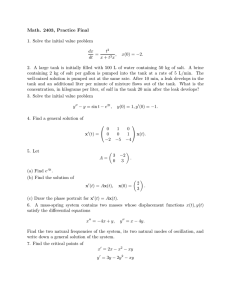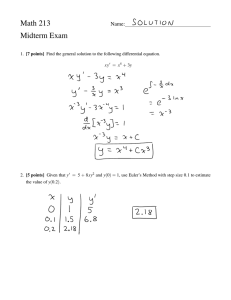TRUCHEK

TRU CHEK
®
Continuous Monitoring
Tank-Tightness Testing
To enhance the environmental protection that a Xerxes double-wall tank provides, many customers choose TRUCHEK ® , a tank leak-detection system that uses a simple, yet highly effective method for monitoring the tank interstice. When choosing
TRUCHEK, tank owners receive the benefit of state-of-the-art leak detection monitoring along with the added feature of thirdparty verified tank tightness test capability.
Continuous Monitoring
The petroleum equipment industry, tank owners and UST regulators have come to define continuous monitoring as a leak- detection method which uses a constant vacuum, air pressure or hydrostatic pressure on the interstice of a double-wall tank, pipe or sump. When Xerxes customers choose TRUCHEK, the interstice is factory filled with an environmentally safe brine solution, creating a small hydrostatic pressure on both tank walls. The brine solution level is then monitored within a tank top reservior for any change in level, either up or down.
Consider the following features and benefits:
Monitor Both Walls – TRUCHEK provides continuous, 24/7 leak detection for both the primary- and secondary-tank walls in ALL buried environments - dry hole or wet hole. The alternative method, which uses a simple liquid-sensing probe in a dry interstice, can effectively monitor the primary-tank wall if the probe is in the proper position, but the secondary containment has no effective monitoring unless the tank happens to be sitting in groundwater. Do not wait for a primary-tank leak to discover that your secondary containment is not tight.
Changing Regulations – Certain states require either continuous monitoring of double-wall tanks, or expensive periodic testing of the tanks interstice when just a probe/sensor is used. Additional states are planning to incorporate similar regulations as a way of verifying the integrity of secondary containment. TRUCHEK hydrostatic monitoring is the answer to these increasing regulatory requirements and the added expense that goes with having to perform intersticial testing.
Proven Track Record – Hydrostatic monitoring is not a new technology - it has been used in tens of thousands of double-wall
FRP tanks for over 25 years. The majority of FRP tanks installed in North America today incorporate hydrostatic monitoring and the number of customers who choose this option is growing annually.
Reservoir
Level Down
How does TRUCHEK work?
Reservoir
Level Down
Reservoir
Level Up
Leak in
Outer Wall
Primary-Tank Leak in
Wet Hole or Dry Hole
Secondary-Tank Leak in Dry Hole Secondary-Tank Leak in Wet Hole
Tank-Tightness Testing
In addition to continuous monitoring, TRUCHEK also provides tank owners with the ability to perform a tightness test on the primary tank. There are two tightness testing options, both of which are easy to perform and are based on industry recognized and accepted test criteria.
Consider the following features and benefits:
A Recognized Testing Method – TRUCHEK tightness testing has third-party verification from UL as meeting EPA and NFPA
329 tank-tightness testing criteria. Additionally, TRUCHEK data has been reviewed by the well respected National Work Group on Leak Detection Evaluations (NWGLDE) and verified as compliant with acceptable test protocols.
10-Hour Test Procedure – Using a 10-hour tightness-test procedure while the tank is not in use, TRUCHEK is capable of detecting a loss of liquid in the tank at a rate of 0.05 gallons per hour with a 99% probability of detection
(PD) and a 1% probability of false alarm (PFA). This meets the strict NFPA
329 criteria.
4-Hour Test Procedure – A shorter 4-hour test, which allows product dispensing, is capable of detecting a loss of liquid in the tank at a rate of
0.05 gallons per hour with a 95% probability of detection (PD) and a 5% probability of false alarm (PFA). This shorter test exceeds EPA’s criteria for a tank-tightness test stating that a test must be able to detect a leak rate of
0.1 gallon per hour with a 95% PD and 5% PFA.
Calibrated Dipstick or Ruler
Monitoring Fluid in Standpipe
(during test only)
© 2013 Xerxes Corporation
7901 Xerxes Avenue South, Minneapolis, MN 55431 USA
952-887-1890 www.xerxes.com
XTT10/13ih





